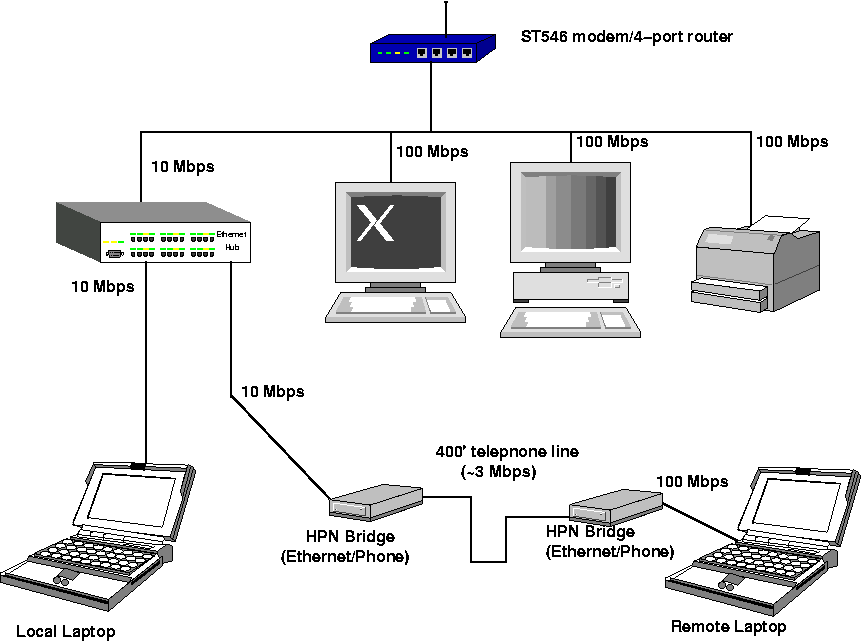LAN Speed Issues
Revised Setup as of Thu 13 Apr 2006 04:43:27 PM EDT
The following figure shows how LAN speeds can vary over different parts of the LAN. Many Ethernet devices are "10/100" Mbps in that they adapt to the speed of the device connected at the other end of the wire.
Because the Ethernet hub happens to be a 10 Mbps device, all 10/100 devices connected to it do so at 10 Mbps. The Home Phone Network (HPN) Ethernet to phoneline bridges indicate an Ethernet connection at 10 Mbps or 100 Mbps.
However, the "remote laptop" will experience a maximum data rate of about 3 Mbps, a limitation of its connection being over 400 feet of telephone wire.

Addendum Thu 13 Apr 2006 10:40:41 PM EDT
With reference to the above diagram, you can get the following information from the web interface, or a telnet session:
=>eth iflist
Intf Type Result Type
1 auto 10BaseTHD
2 auto 100BaseTFD
3 auto 100BaseTFD
4 auto 100BaseTFD
=>
Note the speed of "Interface 1", (10BaseTHD) which is the position of the 10 Mbps Ethernet hub.
Added Fri 14 Apr 2006 08:51:41 AM EDT
IEEE 802 & all that ...
See http://www.speedtouchdsl.com/ST610%5CAppNotes/AppNote_EthernetConnectivity.pdf for an excellent explanation of the terms and concepts involved with Ethernet networking. For example, if you were wondering about THD/TFD (twisted wire, half/full duplex), the "collision" LED on your hub ...
"An important consequence for the end-user is that the half or full duplex mode of an Ethernet segment influences
the aggregate bandwidth of the communication environment. E.g., a 10Mb/s full duplex system exhibits an aggregate
bandwidth of 20Mb/s, whereas a 10Mb/s half duplex system exhibits an aggregate bandwidth of only 10Mb/s."
In a half duplex situation "In order to create a shared communication environment, only a single station is allowed to transmit at any one time. All other stations should be in listening mode. If more than one station is transmitting at the same time, a collision condition occurs. The involved transmitting nodes revert to back-off state and wait for a random period of time before retransmitting their data."
If the above isn't sufficient for your needs, a definitive source of all of this information (including both wired and wireless) is of course http://standards.ieee.org/getieee802/
